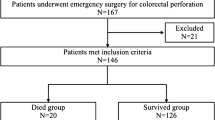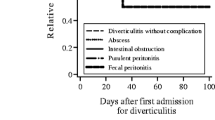Abstract
Colonic perforation is an abdominal emergency with high morbidity and mortality. This retrospective study was performed to evaluate the prognostic relevance of several factors and to characterize patients at high risk. One hundred and twelve patients (61 women, 51 men) were treated for colonic perforation from 1979 to 1992. Diverticulitis [65 patients (58%)] and carcinoma [24 patients (21%)] were the commonest pathology. In 62 cases (55%) perforation was found to be covered; 50 (45%) times it was free. 34 (30%) patients had diffuse peritonitis. Resection with primary anastomosis was performed 43 times (7 times with a protective colostomy). Resection without restoration of the intestinal continuity was carried out 53 times (including 49 Hartmann operations). Suture with drainage was performed 16 times mainly after iatrogenic perforation (8 times with a colostomy). The overall mortality was 19.6% (22 patients). The prognostic importance of various factors was investigated by univariate analysis (Wilcoxon and Chi-square test) and stepwise logistic regression including sex, age, underlying disease, localization and type of perforation, degree of peritonits, per-or postoperative organ failure, surgical procedure, reoperation, sepsis and the Mannheimer Peritonitis Index (MPI) score. Age over 65 years (relative risk 4.6, P=0.0089), organ failure (relative risk 40, P=0.001) and MPI (relative risk for an increase of 10 points 2.72, P=0.001) proved to be the only risk factors of significance. The patient's course is determined by the septic state, while the underlying pathology and degree of peritonitis did not significantly influence survival.
Résumé
Une perforation colique est une urgence abdominal grevée d'une mortalité et d'une morbidité élevées. Cette étude rétrospective a été entreprise pour évaluer la valuer pronostique d'une série de facteurs et pour caractériser les patients présentant le plus haut risque de complications. Cent-douze patients (61 femmes et 51 hommes) ont été traités pour des perforations coliques entre 1979 et 1992. La diverticulite (65 patients = 58%) et le cancer (24 patients=21%) sont les pathologies les plus courantes. Dans 62 cas (55%) la perforation était couverte, chez 50 malades (45%) elle était en péritoine libre. Trente-quatre (30%) étaient porteurs d'une péritonite diffuse. Une résection avec anastomose premiè a été réalisée 43 fois (7 fois avec une colostomie de protection). La résection sans rétablissement de la continuité immédiate a été réalisée 53 fois (49 fois selon le procédé de Hartmann). Une suture avec drainage a été réalisée 16 fois, le plus souvent après des perforations iatrogéniques (8 fois avec une colostomie protectrice). La moratalité globale était de 19,6% (22 patients). L'importance pronostique des différents facteurs a été étudiée par une analyse de variables isolées (tests de Wilcoxon et Chi-square) et une analyse des facteurs de régression incluant le sexe, l'âge, la pathologie sous-jacente, la localisation, le type de perforation, le degré de péritonite, les défaillances organiques pré- et post-opératoires, la technique chirurgicale, les réopérations, l'asepsie et l'index de péritonite de Mannheim (MPI). Les seuls facteurs de pronostic qui ont été identifiés sont: l'âge au-delà de 65 ans (un risque relatif de 4,6, P=0.0089), une défaillance organique (risque relatif de 40, P=0.001) et l'index MPI (risque relatif pour une augmentation de 10 points 2,72, P=0.001). L'évolution du patient est déterminée par l'état septique alors que la pathologie sous-jacente et le degré de péritonite n'ont pas d'influence sur la survie.
Similar content being viewed by others
References
Mealy K, Salman A, Arthur G (1988) Definitive one-stage emergency large bowel surgery. Br J Surg 75:1216–1219
Krukowski Z, Matheson N (1984) Emergency surgery for diverticular disease complicated by generalized and fecal peritonitis: a review. Br J Surg 71:921–927
Runkel N, Schlag P, Schwarz V, Herfarth C (1991) Outcome after emergency surgery for cancer of the large intestine. Br J Surg 78:183–188
Greenstein A, Barth J, Sacher D, Aufses A (1986) Free colonic perforation without dialatation in ulcerative colitis. Am J Surg 152:272–275
Hall C, Dorricott N, Donovan I, Neoptolemos J (1991) Colon perforation during colonoscopy: surgical versus conservative management. Br J Surg 78:542–544
Serpell J, Nicholls RJ (1990) Stercoral perforation of the colon. Br J Surg 77:1325–1329
Botsford T, Zollinger R, Hicks R (1971) Mortality of the surgical treatment of diverticulitis. Am J Surg 121:702–705
Eng K, Ranson J, Localio A (1977) Resection of the performed segment. Am J Surg 133:67–72
Rodkey G, Welch C (1984) Changing patterns in the surgical treatment of diverticular diseases. Am Surg 200:466–478
Linder M, Wacha H, Feldmann U, Wesch G, Gundlach E, Streifensand R (1987) Der Mannheimer Peritonitis-Index. Chirurg 58:84–92
Madden J (1966) Treatment of perforated lesions of the colon by primary resection and anastomosis. Dis Colon Rectum 9:413–416
Thow G (1980) Emergency left colon resection with primary anastomosis. Dis Colon Rectum 23:17–24
Kelley W, Brown P, Lawrence W, Terz J (1981) Penetrating, obstructing and perforating carcinomas of the colon and rectum. Arch Surg 116:381–384
Kyllonen L (1987) Obstruction and perforation complicating colorectal carcinoma. Acta Chir Scand 153:607–614
Albrechtsen D, Bergon A, Nygaard K, Gjone E, Flatmark A (1981) Urgent surgery for ulcerative colitis: early colectomy in 132 patients. World J 5:607
Bundred N, Dixon J, Lumsden A (1985) Free perforation in Crohn's colitis: a ten-year revies. Dis Colon Rectum 28:35
Steinberg D, Cook W, Alexander-Williams J (1973) Free perforation in Crohn's disease. Gut 14:187
Jones P (1987) Emergency abdominal surgery, Blackwell, Oxford London, pp 261–268
Goligher J (1975) Surgery of the anus, rectum and colon, 3rd edn. Bailliere Tindall, London
Waldron R, Donovan I (1986) Mortality in patients with obstructing colorectal cancer. Ann R Coll Surg Engl 68:219–221
Dutton J, Hreno A, Hampson L (1976) Mortality and prognosis of obstructing carcinoma of the large bowel. Am J Surg 131:36–41
Nagorney D, Adson M, Pemberton J (1985) Sigmoid diverticulitis with perforation and generalized peritonitis. Dis Colon Rectum 28:71–75
Gregg R (1987) An ideal operation for diverticulitis of the colon. Am J Surg 153:285–290
Bone R, Fisher C, Clemmer T, Slotman G, Metz C, Balk R (1989) Sepsis syndrome: A valid clinical entity. Crit Care Med 17:389–393
Author information
Authors and Affiliations
Rights and permissions
About this article
Cite this article
Kriwanek, S., Armbruster, C., Beckerhinn, P. et al. Prognostic factors for survival in colonic perforation. Int J Colorect Dis 9, 158–162 (1994). https://doi.org/10.1007/BF00290194
Accepted:
Issue Date:
DOI: https://doi.org/10.1007/BF00290194




